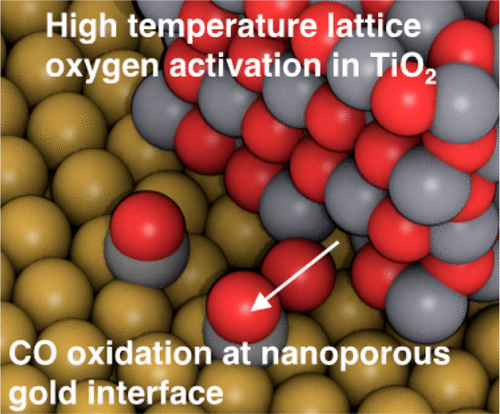当前位置:
X-MOL 学术
›
J. Phys. Chem. C
›
论文详情
Our official English website, www.x-mol.net, welcomes your feedback! (Note: you will need to create a separate account there.)
Thermally Activated Formation of Reactive Lattice Oxygen in Titania on Nanoporous Gold
The Journal of Physical Chemistry C ( IF 3.7 ) Pub Date : 2017-09-25 00:00:00 , DOI: 10.1021/acs.jpcc.7b06316 Bradley W. Ewers 1 , Andrew S. Crampton 1 , Monika M. Biener 2 , Cynthia M. Friend 1
The Journal of Physical Chemistry C ( IF 3.7 ) Pub Date : 2017-09-25 00:00:00 , DOI: 10.1021/acs.jpcc.7b06316 Bradley W. Ewers 1 , Andrew S. Crampton 1 , Monika M. Biener 2 , Cynthia M. Friend 1
Affiliation

|
Nanoporous gold modified by atomic layer deposition of titania was employed as a model, inverse supported precious metal catalyst to explore the oxidative reactivity of Au/TiO2 catalysts. The catalyst material is active for oxidation of CO using O from the titania lattice, even at low temperatures. The reactive lattice oxygen available for oxidative reactions was formed by thermal activation, with the total oxidative reactivity of the material showing a strong dependence on the annealing temperature prior to CO exposure. Finally, reduction of the titania via CO oxidation can be reversed under relatively mild conditions by exposure to O2, presenting a viable mechanism for CO oxidation in steady state catalytic conditions.
中文翻译:

纳米多孔金在二氧化钛中热活化形成活性晶格氧
以二氧化钛原子层沉积改性的纳米多孔金为模型,采用逆负载型贵金属催化剂研究了Au / TiO 2催化剂的氧化反应性。即使在低温下,该催化剂材料对于使用来自二氧化钛晶格的O氧化CO也是有活性的。可用于氧化反应的反应性晶格氧是通过热活化形成的,该材料的总氧化反应性与暴露于CO之前的退火温度密切相关。最后,通过暴露于O 2在相对温和的条件下可以逆转通过CO氧化还原二氧化钛,这表明在稳态催化条件下CO氧化的可行机理。
更新日期:2017-09-25
中文翻译:

纳米多孔金在二氧化钛中热活化形成活性晶格氧
以二氧化钛原子层沉积改性的纳米多孔金为模型,采用逆负载型贵金属催化剂研究了Au / TiO 2催化剂的氧化反应性。即使在低温下,该催化剂材料对于使用来自二氧化钛晶格的O氧化CO也是有活性的。可用于氧化反应的反应性晶格氧是通过热活化形成的,该材料的总氧化反应性与暴露于CO之前的退火温度密切相关。最后,通过暴露于O 2在相对温和的条件下可以逆转通过CO氧化还原二氧化钛,这表明在稳态催化条件下CO氧化的可行机理。



























 京公网安备 11010802027423号
京公网安备 11010802027423号